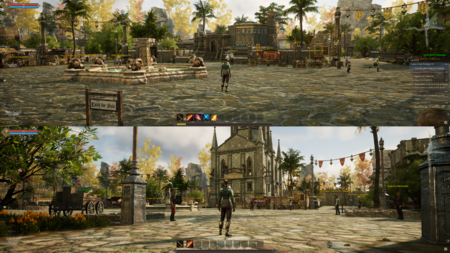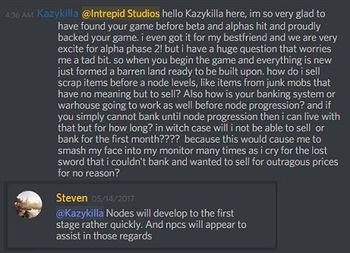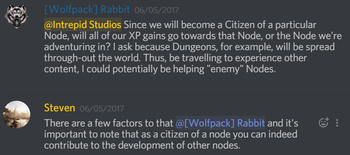Influencia racial

We have essentially sets that exist across all races; and each race that dons those armor sets is going to have their own racial influence on the presentation of those particular sets. So that's something that's unique in how each of the races get diversified. Additionally, the more that one particular race contributes to a node's development, it's going to manifest in that particular node's architectural influences. You're going to see the architectures of those races become manifest within the nodes as well: That's another way that we diversify each race and we present each race's culture in the game as through those architectures, through those props that exist, through the tailoring of the armor sets that the NPC might wear, to the different factions that exist. Factions will have their own affiliation with different races as well. Each race will also have some different nomenclature when it comes to the lore, or comes to locations in the world. They're going to have their own language influences as well: The way they speak is something that's going to be distinct between races; when you have dialogue trees with particular NPCs. So all of those things really go into setting an immersive world where the cultures have their own identity.[2] – Steven Sharif
La influencia cultural se manifiesta diferentes formas, desde la estética de los nodos y el equipo hasta en el lenguaje de los PNJ y el lore.[2][3][4]
- La apariencia del equipo de ciertos sets de armaduras viene influenciada por la raza del jugador.[2]
- El diseño y estilo del nodo está influenciado por la raza que más contribuye ha ese nodo.[2]
- Los beneficios puede que apliquen a los ciudadanos de la cultura dominante, pero también aplica a las mecánicas del nodo, lo que podrá ser beneficioso también a los miembros de otras razas.[3]
- Hay una mecánica de desgaste, que afecta a la experiencia y a la influencia para evitar que una sola raza domine el mundo entero.[5]
- Los PNJs reaccionarán de forma diferente dependiendo de la raza del personaje.[6]
- Los idiomas serán diferentes según la raza del PNJ y en el lore.[2]
There is an attrition and that attrition on experience and influence is heightened based on the performance of the race in the world. So if all these nodes are Orc nodes then their attrition rate is very high to compete with the cultural establishment of new nodes because they have more influence in the world and a popular opinion is against them in their outlying regions that they do not have influence in.[5] – Steven Sharif
Influencias artísticas
Las razas de los personajes son muy importantes. Estas son las decisiones que tomamos al principio de nuestra aventura en un MMORPG: La raza no solo se alinea mecánicamente con nuestras decisiones. Estas razas tienen mecánicas de juego detrás de ellas desde un punto de vista de estadísticas, además de visual, cultural e históricamente. ¿Cuáles son? ¿Qué representan estas razas? Así pues es importante que sean distintos. Todo el mundo ha visto juegos de fantasía con Elfos, Humanos y Orcos; casi hay una expectativa establecida detrás de lo que cada una de estas razas de tradicionales en la fantasía representan; y existe un riesgo, porque cuando estar creando una nueva IP o un nueva historia o mundo en un nuevo universo, un reino en donde las cosas no tienen que seguir la norma establecida, te puedes comtar ciertas libertades creativas para redefinir ciertos aspectos de una raza en particular; y eso puede ser algo bueno, porque es algo nuevo para los jugadores. Es algo único dentro del mundo que estamos construyendo y del entorno que tienes. Por lo tanto, lo que queríamos hacer era impulsar un poco más como se verían los Py´rai desde una perspectiva visual.[7] – Steven Sharif
- La arquitectura aelana está muy influenciada por la Francia del medievo.[8]
- Los Dünir estan influenciados por las culturas nórdicas.[9]
- Los Empyreanos tienen influencias Greco-Romanas.[10]
Los Kaelar tienen influencias Europeas.[11]
- Los Niküa tienen influencia de las culturas polinesas.[12][10]
- Los Py'Rai están influenciados por los Nativos Americanos del pueblo Navajo.[10] La arquitectura Py'Rai está inspirada en las zonas boscosas.[13]
- La arquitectura pyriana tiene influencias Greco-Romanas[14]
Los Vaelune tienen una influencia de Oriente Medio.[15]
Los Vek están influenciados por las culturas mesoamericanas.[15]
Los jugadores verán las distintas influencias de las culturas del mundo real reflejadas en las distintas razas del juego: No sólo influencias europeas, africanas o mesoamericanas. Estas culturas estarán presentes en muchas de las razas.[16] – Steven Sharif
La idea es encontrar un componente base en el mundo real y tomarlo como punto de partida. A partir de ahí empiezas a fantasear y construir.[8] – Steven Sharif
Estilo y diseño de los nodos

The layout and architecture within a Node’s development area are determined by influential race. For example, a stage 3 Node with the majority of player contribution being Py'rai would have a Py'rai village with Py'rai architecture. Most NPCs would be Py'rai elves, and offer questlines within the Py'rai narrative.[17] – Margaret Krohn
Each player’s contributed experience is flagged with their character race and other identifiers. When a Node advances, the race with the highest experience contribution determines the Node’s style and culture. This style and culture change can happen at every Node Stage. For example, if a Node advances to Level 2 - Encampment Stage and 51% of all experience was earned by Ren’Kai players, the Node will be a Level 2 Ren’Kai Node. If that same Node advances to a Level 3 - Village Stage Node, but the Py'Rai contributed 62% of all the experience earned, then the Node will be a Level 3 Py'Rai Node.[4] – Margaret Krohn
El diseño de un nodo y su estilo es determinado por varios factores:[18]
- La localización y el entorno (bioma) del nodo.[19][20][18]
- Nodes will adjust the local topography to fit the aesthetic and mechanical requirements of the node.[19] – Steven Sharif
- Los nodos ajustarán la topografía local para adaptarse a los requisitos estéticos y mecánicos del nodo.[21]
Currently the way that the platform system is set up, is it's capable of adjusting the topography of the node's footprint, regardless of the surrounding terrain. So the reason for that is we want to have flexibility in the presentation of the node's layout and how it is essentially both from an aesthetic standpoint as well as a mechanical standpoint with node sieges- how it's constructed and that construction should have the ability to take on a variance of different types of topography. So it shouldn't be dependent on the surrounding area. Now that's not to say that the surrounding area isn't going to have some influence over. So for example... we're experimenting a little bit with the platform tech and putting up a node up against the side of a mountain or on the edge of a cliff or something that has a beautiful vista. Those are things that we're going to test out obviously as we continue to work on the node tool and how that platform system works, but the idea is to have the node independent of the surrounding terrain.[21] – Steven Sharif
- El tipo de nodo.[18]
Some parts are determined by the area it's in. Some parts are determined by the type it is. Some parts are determined by the race it is; and then the rest of it is determined by the mayor.[18] – Jeffrey Bard
- La raza que contribuya con el porcentaje más alto al avance del nodo modificará la apariencia racial de sus edificios, NPCs y objetos.[22][20][4][18][23][24]
- Las razas relacionadas entre ellas no combinan sus influencias culturales. Por ejemplo, los Py'Rai y los Empyrean cuentan como culturas diferentes. Su raza madre, los Pyrian, ya no existen.[25]
- Este cambio de estilo y cultura ocurre en cada etapa del nodo.[4]
- Esto aplica para todos los nodos, incluso los nodos de castillo.[26]
All nodes whether they're associated with a castle or associated with normal node structure has cultural influences that replicate over to the buildings that are produced and the NPCs that are present.[26] – Steven Sharif
- El resto es determinado por el alcalde del nodo.[18]
- Debería ser posible completar varios proyectos de construcción en un nodo durante el mes en el que el alcalde ostenta su cargo.[27]
- Q: How long would you say it will take players on average to fill slash build up a node completely from wilderness to metropolis?
- A: It's one thing to get a node to a certain level: it's another thing to develop the node; and I can't really give you an on-average expectation, because there's a lot of variables at play. There's how many citizens does the node have attracted to it; what's the type of traffic that the node is attracting to it based on things like its tax rates, or the specialization that it chose to spec into, based on the building types it's chosen to build. All of those things are variables that can affect the quote-unquote "average build-out time" of a particular node. So it's difficult to give you an average when there's so many variables along those lines. But the idea is that if there is a particular project that players are interested in in developing based on the node stage, that they would have the ability to complete several of those projects as within a single term of a mayor; and a term of a mayor is one month.[27] – Steven Sharif
Avance del nodo
La actividad de los jugadores, ciudadanos y no ciudadanos, como (questear, recolectar, raids, etc.) dentro de la ZOI de un nodo contabiliza para el avance de ese nodo en particular (progresión) a una fase superior.[4][28]
El avance de un nodo desbloquea sus ventajas únicas, aunque puede bloquear el avance de los nodos vecinos hacia sus siguientes fases, al incrementar su anillo de influencia.[29]
- Los nodos avanzan hacia su primera fase muy rápido. Esto habilita algunos PNJs como vendedores o el almacenamiento de objetos.[30]
- Cuanto más avanza el nodo, más ámplia se vuelve su ZOI.[31]
- Los nodos menos evolucionados (conocidos como nodos vasallos) que entran dentro de la ZOI de otros nodos pueden seguir ganando experiencia, pero siempre permanecerán en una fase inferior a la del nodo dominante.[32]
- El sistema de vasallaje comienza cuando un nodo alcanza la fase de Aldea (fase 3), sin embargo, los nodos vecinos a partir de la fase Expedición (fase 1)también bloquean el avance de sus propios nodos vecinos.[33][34]
- El algoritmo de expansión de territorio tiene en cuenta la costa más cercana, los nodos vecinos y el "mapa de calor" de los jugadores en las zonas circundantes durante las últimas semanas y meses.[35]
- Debido la forma en la que el algoritmo calcula la expansión del territorio (ZOI) durante el avance del nodo, hay una pequeña posibilidad de que nodos nodos en la misma fase terminen estando el uno cerca del otro.[36]
- The way that the algorithm expands the territories takes into account a few things: One it takes into account the coast like where's the closest coast. Two it takes into account the neighboring nodes so it can take over and essentially vassal state those nodes, but what's more important is essentially the initial population based on like how players choose their races. Because we have nine different races and four different starting points that branch out, each server's population density is going to dictate essentially the first few nodes that are highly populated and then that initial seed is what's going to determine the node structure as it moves inland into the into the world essentially; and based on the performance and successes of different sieges will determine which nodes that got locked out from the previous the initial advancements what nodes can now be available to advance further. So I really think that with so many variables that are present in the equation of how nodes advance and stay existing with the more variables you have, the higher likelihood there is for there to be a significant diversion in world progression.[35] – Steven Sharif
- Normally the algorithm that's applied to the node territorial expansion will prevent significant nodes from being in close proximity to each other... There could be a perfect storm where all of the algorithmic progression of territory leads to having these nodes very close to each other because there's certain requirements that should that need to be available to satisfy node vassal takeovers; and it's possible that two nodes would never take each other over as vassals and end up close together and spanning their territories in opposite directions: The Tale of Two Cities thing.[36] – Steven Sharif
- Un nodo no recibirá experiencia de los nodos dentro de su ZOI hasta que ese nodo no haya alcanzado su límite.[32]
- Los ciudadanos de un nodo pueden contribuir al avance de otros.[37]
- El porcentaje de experiencia que ganan los nodos será equitativa entre los cuatro tipos de nodo.[38]
- Different people have different resources invested in nodes progressing and it would be a little "gamey" if you could know exactly what was necessary at that point because that would disincentivize people from participating.[39] – Steven Sharif
La mejora del nodo mostrará una serie de animaciones y efectos visuales (dentro del área del nodo).[40][4]
- Los jugadores serán desplazados a zonas seguras si se cruzan con nuevos objetos generados durante el avance del nodo.[40][41]
- Los recursos aparecerán al rededor del nodo y el sistema mostrará una serie de caravanas llegando al nodo con esos recursos. Estas caravanas no podrán ser atacadas.[40]
- Algunos PNJs comenzarán con actividades de construcción.[40]
- Los jugadores fuera del nodo podrán ver como el aspecto del nodo va cambiando a medida que avanza hacia su nuevo nivel.[40]
- The Development Area of a Node is where civilization will appear as the Node advances. As the Node Stage increases, different buildings, NPCs, and services will become available in the Development Area. The higher the Node Stage, the more complex and populated the Development Area becomes. Development Areas will also vary depending on the Node Type - Economic, Military, Scientific, or Divine.[4] – Margaret Krohn
NPC racial interaction
#REDIRECT MediaWiki:Story arc quests/es
Las líneas de misiones pueden tener varias fases. Estas fases de cada misión pueden terminar en fallo.[42]
- La posibilidad de volver a intentar una misión fallida depende de la progresión del nodo.[42]
- Las misiones que implican a ciudadanos de diferentes nodos se desbloquean en función de las allianzas así como otras relaciones entre nodos y su progresión.[43]
- Las misiones pueden variar en función de la fase actual de los nodos cercanos, la influencia de la estación, y de eventos como jefes de mundo.[44]
There will be many different quests that actually have stages of the storyline; and these stages can actually be failed. You can actually fail a storyline; which sucks when you think about it, but at the same time that risk makes your investment that much more important.[42] – Steven Sharif
Ver además
Referencias
- ↑ Transmisión en vivo, 2020-06-26 (45:32).
- ↑ 2.0 2.1 2.2 2.3 2.4 Transmisión en vivo, 2022-03-31 (4:57).
- ↑ 3.0 3.1 Entrevista, 2021-02-07 (33:00).
- ↑ 4.0 4.1 4.2 4.3 4.4 4.5 4.6 Blog - Know Your Nodes - Advance and Destroy.
- ↑ 5.0 5.1 Entrevista, 2018-05-11 (1:00:19).
- ↑ Pódcast, 2018-04-23 (29:56).
- ↑ Transmisión en vivo, 2022-02-25 (49:42).
- ↑ 8.0 8.1 Entrevista, 2018-10-20 (3:47:17).
- ↑

- ↑ 10.0 10.1 10.2 Entrevista, 2018-05-11 (1:03:21).
- ↑ Pódcast, 2018-05-11 (31:35).
- ↑ Transmisión en vivo, 2022-09-30 (1:08:24).
- ↑

- ↑ Transmisión en vivo, 2017-10-16 (15:58).
- ↑ 15.0 15.1 Pódcast, 2018-05-11 (31:35).
- ↑ Entrevista, 2018-05-11 (1:04:27).
- ↑ Blog - Know Your Nodes - The Basics.
- ↑ 18.0 18.1 18.2 18.3 18.4 18.5 Transmisión en vivo, 2018-09-27 (53:06).
- ↑ 19.0 19.1 Transmisión en vivo, 2022-02-25 (41:00).
- ↑ 20.0 20.1 Transmisión en vivo, 2020-10-30 (39:17).
- ↑ 21.0 21.1 Transmisión en vivo, 2021-02-26 (1:12:18).
- ↑ Pódcast, 2021-04-11 (29:47).
- ↑ Entrevista, 2018-05-11 (54:34).
- ↑ Transmisión en vivo, 2017-05-26 (21:23).
- ↑ Pódcast, 2021-04-11 (23:36).
- ↑ 26.0 26.1 Entrevista, 2018-05-11 (47:27).
- ↑ 27.0 27.1 Transmisión en vivo, 2022-07-29 (1:13:09).
- ↑ A reactive world - Nodes.
- ↑ Vídeo, 2017-04-20 (0:02).
- ↑

- ↑ Node series part II – the Metropolis.
- ↑ 32.0 32.1 Transmisión en vivo, 2017-10-16 (50:20).
- ↑

- ↑

- ↑ 35.0 35.1 Entrevista, 2020-07-18 (10:04).
- ↑ 36.0 36.1 Entrevista, 2020-07-08 (1:00:15).
- ↑

- ↑ Transmisión en vivo, 2021-09-24 (1:21:23).
- ↑ 39.0 39.1 Transmisión en vivo, 2017-05-26 (28:16).
- ↑ 40.0 40.1 40.2 40.3 40.4 Transmisión en vivo, 2022-10-14 (55:13).
- ↑ Transmisión en vivo, 2017-11-17 (55:27).
- ↑ 42.0 42.1 42.2 Entrevista, 2018-10-20 (2:36:25).
- ↑ Transmisión en vivo, 2020-07-25 (1:50:20).
- ↑ Transmisión en vivo, 2021-03-26 (1:12:51).